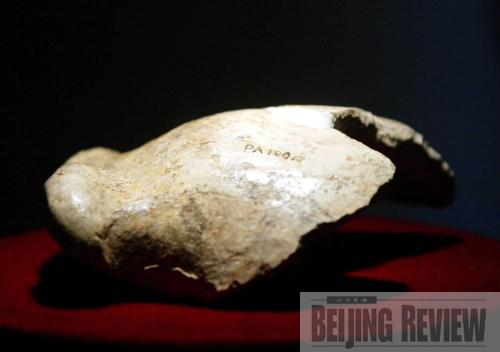|
 |
|
A MYSTERIOUS TREASURE: A fossil skull (frontal bone) of Peking Man is on display in the Zhoukoudian Peking Man Museum. On December 2, 1929, Chinese archaeologist Pei Wenzhong discovered the first complete skullcap of Peking Man in Zhoukoudian, Beijing (XINHUA) |
A March 12 cover story in Britain's science journal Nature made Peking Man a hot topic once again. The article, written by Chinese and American researchers, argues that Peking Man may be 770,000 years old, a full 270,000 years older than scientists had estimated. Previous research had set the fossil's age at 400,000-500,000 years old. The findings in the article were uncovered by Shen Guanjun, a professor with the College of Geographic Sciences at Nanjing Normal University, Gao Xing, Deputy Director of the Institute of Vertebrate Paleontology and Paleoanthropology at the Chinese Academy of Sciences and Darryl Granger, a professor with the Department of Earth and Atmospheric Sciences at Purdue University in the United States.
Peking Man, also called Sinanthropus pekinensis (currently Homo erectus pekinensis), is an example of Homo erectus. On December 2, 1929, 25-year-old Chinese archaeologist Pei Wenzhong discovered the first complete skullcap of Peking Man in Zhoukoudian, about 50 km southwest of Beijing. Seven years later, 28-year-old Chinese archaeologist Jia Lanpo and his team found three skullcap fossils in 11 days in the same area. But the fossil skullcaps were lost during the Japanese invasion (1936-1945), leaving a mystery for the world. In the 1960s, a new excavation unearthed two pieces of Peking Man's skull fragments.
Over the past few decades, scientists have used many kinds of dating methods to test the age of Peking Man. But because different kinds of dating methods were useful in ascertaining only certain age ranges, their results were often conflicting.
"Dating tests are important to the research of paleoanthropology," said Gao. The accuracy of ages plays a decisive role in investigating the evolutionary processes and migration routes of ancient human ancestors.
The new discovery is attracting more visitors to Zhoukoudian. The State Administration of Cultural Heritage authorized scientists working in Zhoukoudian in the suburb of southwestern Beijing to launch a four-month excavation project that will uncover 20 square meters.
Quartz sands
Shen returned to China from France in 1985 and began studying Peking Man. He said the new discovery was found among the area's silica quartz sands.
"Every conclusion made about the age in which Peking Man lived was made by paleontologists and archaeologists studying fossils and the strata in which they were found," said Shen. But the skeleton fossils, he believed, were not ideal for dating because the information recorded in the fossil bones was unstable and would lead to large errors. He looked for answers in the stalactites hanging in the caves where Peking Man is thought to have lived.
Years later, Shen tested the first two layers in the stalactites and concluded the ones he was looking for were 420,000 years old, 100,000 years earlier than previously concluded. The sediments at Zhoukoudian can be divided into 17 layers and from the 10th there began appearing human traces. "If the ages in the first and second layers are over 400,000 years old, the number will be bigger in the 10th layer. It is obvious that the estimates of 400,000-500,000 years are underestimated," Shen said.
The first determination of the age of Peking Man was made in the late 1970s. Researchers found that the ages of the bone fossils in the first three layers of the sediments were 230,000 years old and that those in the 10th layer were 500,000 years old.
In 1991, Yuan Sixun and Chen Tiemei, experts with the Geochronology Laboratory of the Department of Archaeology at Peking University, made further studies into the bone fossil samples by using the uranium series method and found that the ages of the first to third layers were earlier than some formulations of the day and the ages of the bottom of the second layer and that the fourth layer were respectively 270,000 years and 300,000 years.
|
